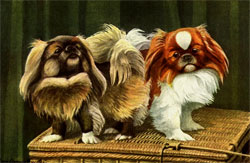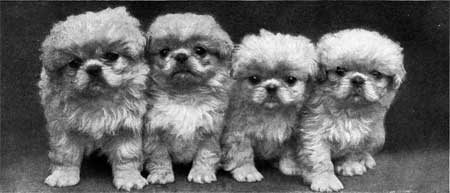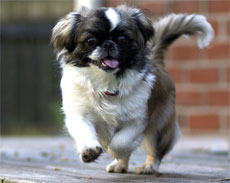|

 If the look works, keep it: The Pekingese breed is over 2000 years old and has hardly changed in all that time. One exception is that modern breeders and dog-show judges seem to prefer the long-haired type over the more-traditional spaniel-type coat. Pekes weigh from 7 to 14 pounds (3-6 kg) and stand about 6-9 inches (15-23 cm) at the withers. If the look works, keep it: The Pekingese breed is over 2000 years old and has hardly changed in all that time. One exception is that modern breeders and dog-show judges seem to prefer the long-haired type over the more-traditional spaniel-type coat. Pekes weigh from 7 to 14 pounds (3-6 kg) and stand about 6-9 inches (15-23 cm) at the withers.
All breed standards allow all sorts of color combinations. The most common is red sable; this is the color of the majority of Westminster Pekes. Black and tan is popular as well, but blonde seems to be preferred over black and tan for show dogs. The solid white (except face) or solid black Pekingese is quite striking. The face is usually black with deep brown eyes. There was, supposedly, in a British Pekingese line, a blue (gray) pekingese. Albino dogs are not within the standard.
Walk the Line: The Pekingese gait is like no other in the dog world. Because the Chinese originally bred them to be companions to the Emperor of China and his ladies and eunuchs, they are bowlegged to discourage wandering. However, they can and will keep up with the big dogs when allowed. The bowleggedness makes their walk, run, or trot quite striking.

 Jealous Fools: These dogs can be stubborn and jealous. This is not a dog for someone who wants a dog that always comes when it is called. Pekes are sometimes aggressive, especially to other dogs. It may take a long time for Pekes to get used any other dogs except puppies, mates, and siblings. However, Pekes can be properly socialized with dogs and other types of pets and can become fast friends. It is easy to believe that Pekes know that they are royalty and expect you to know it, too. This might make them unsuitable for the first-time dog owner. The Pekingese personality has been compared to a cat, although this isn't quite right. Where a cat can be trained, a Pekingese needs to be convinced that the training is beneficial to him as well as to you. But, if they love you they will do anything for you, even fight to the death to protect you. Jealous Fools: These dogs can be stubborn and jealous. This is not a dog for someone who wants a dog that always comes when it is called. Pekes are sometimes aggressive, especially to other dogs. It may take a long time for Pekes to get used any other dogs except puppies, mates, and siblings. However, Pekes can be properly socialized with dogs and other types of pets and can become fast friends. It is easy to believe that Pekes know that they are royalty and expect you to know it, too. This might make them unsuitable for the first-time dog owner. The Pekingese personality has been compared to a cat, although this isn't quite right. Where a cat can be trained, a Pekingese needs to be convinced that the training is beneficial to him as well as to you. But, if they love you they will do anything for you, even fight to the death to protect you.
Always Picking Favorites: The Pekingese is generally a one-person dog. They decide who they like best, and it might surprise you. They more than tolerate the others in their person's life, but that person might have to withhold some attention from the Peke if there is a danger that the Peke sees a child as a rival. Most healthy and well-trained Pekes are fine with children. Unfortunately, because they are among the 'cute and I know it' breeds, many people don't properly train their dogs and end up with difficult jealousy problems.
 Health Watch: Pekes' main problems are eye issues and breathing problems, resulting from its tiny skull and flattened face, and skin allergies (and hotspots). An especially common problem is eye ulcers, which may develop spontaneously. Pekes should never be kept outside as their flattened faces and noses can develop breathing problems, which makes it difficult for them to regulate their body temperature in overly hot or cold weather. Their long backs, relative to their legs, make them vulnerable to back injuries. Care should be taken, when picking them up, to give Pekes adequate back support: one hand under the chest, the other under the abdomen. Short legs give some Pekes difficulty with stairs; older dogs may not be able to go up or down stairs alone. Health Watch: Pekes' main problems are eye issues and breathing problems, resulting from its tiny skull and flattened face, and skin allergies (and hotspots). An especially common problem is eye ulcers, which may develop spontaneously. Pekes should never be kept outside as their flattened faces and noses can develop breathing problems, which makes it difficult for them to regulate their body temperature in overly hot or cold weather. Their long backs, relative to their legs, make them vulnerable to back injuries. Care should be taken, when picking them up, to give Pekes adequate back support: one hand under the chest, the other under the abdomen. Short legs give some Pekes difficulty with stairs; older dogs may not be able to go up or down stairs alone.
Beauty Secrets: Keeping the Peke coat healthy and presentable requires brushing once a day. If you do this, they will need to see a groomer only once every 3 months. If a Peke becomes dirty, it is important to take it to a groomer as soon as possible, as it is difficult to remove dirt from its coat once it has dried, but this can be avoided if by brushing regularly, especially the belly, and between the front and hind legs. It is also important to remove dirt from the eye pores daily, and from the creases on the face to prevent sores (hotspots)

King of the Dogs: The breed originated in China in antiquity, most likely from Asian wolves. Recent DNA analysis confirms that the pekingese breed is one of the oldest breeds of dog. For centuries, they could be owned only by members of the Chinese Imperial Palace.
During the Second Opium War, in 1860, the Forbidden City was invaded by Allied troops. The Emperor Xianfeng had fled with all of his court. However an elderly aunt of the emperor remained. When the ‘foreign devils’ entered, she committed suicide. She was found with her five Pekingese mourning her passing.
A New World: They were removed by the Allies before the Old Summer Palace was burnt. Lord John Hay took a pair, later called ‘Schloff’, and ‘Hytien’ and gave them to his sister, the Duchess of Wellington, wife of Henry Wellesley, 3rd Duke of Wellington. Sir George Fitzroy took another pair, and gave them to his cousins, the Duke and Duchess of Richmond and Gordon. Lieutenant Dunne presented the fifth Pekingese to Queen Victoria of the United Kingdom, who named it Looty.

The Empress Dowager Cixi presented Pekingese to several Americans, including John Pierpont Morgan and Alice Lee Roosevelt Longworth, daughter of Theodore Roosevelt, who named it Manchu.

 The Lion and the Marmoset: A lion and a marmoset fell in love. But the lion was too large. The lion went to the Buddha and told him of his woes. The Buddha allowed the lion to shrink down to the size of the marmoset. And the Pekingese was the result. The Lion and the Marmoset: A lion and a marmoset fell in love. But the lion was too large. The lion went to the Buddha and told him of his woes. The Buddha allowed the lion to shrink down to the size of the marmoset. And the Pekingese was the result.
The Butterfly Lions: A lion fell in love with a butterfly. But the butterfly and lion knew the difference in size was too much to overcome. Together they went to see the Buddha, who allowed their size to meet in the middle. From this, the Pekingese came.
Another legend says that the Peke resulted from the mating of a lion and a monkey, getting its nobleness and coat from the former and its ungainly walk from the latter.
Holy Dog: Because the Pekingese was believed to have originated from the Buddha, he was a temple dog. As such, he was not a mere toy. He was made small so that he could go after and destroy little demons that might infest the palace or temple. But his heart was big so that he could destroy even the largest and fiercest. (A book was written from this premise, although the author denies knowledge of the legends: Bride of the Rat God.)
All text is available under the terms
of the GNU Free Documentation License
|
